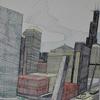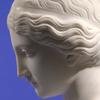Metropolitan Museum Exhibition Features Work of Renowned 19th-Century American Sculptor Augustus Saint-Gaudens
- NEW YORK, New York
- /
- July 27, 2009
Augustus Saint-Gaudens (1848–1907) was a French-Irish immigrant who became the greatest American sculptor of his day. From humble roots, through his prodigious talent, he rose in society, eventually counting some of America's most influential people in art and literature, diplomacy and economics, technology, and social policy among his friends and clients. The collection of The Metropolitan Museum of Art contains nearly four dozen works by the accomplished artist, representing the entire range of his oeuvre, from early cameos to innovative bas-reliefs to character-penetrating portrait busts and statuettes derived from his public monuments. These unparalleled holdings will be supplemented with loans from private collections and public institutions in the exhibition Augustus Saint-Gaudens in The Metropolitan Museum of Art. The presentation will address the artist's groundbreaking position in the history of late-19th-century American sculpture, his role in advancing American art on the international stage, and the long history of presenting and collecting his work at the Metropolitan Museum.
The Eugénie Prendergast Exhibitions of American Art are made possible by a grant from Jan and Warren Adelson.
Additional support for this exhibition is provided by the Laurence Levine Charitable Fund, Inc.
Exhibition Dates: June 30–November 15, 2009Exhibition Location: The Erving and Joyce Wolf Gallery
Exhibition Overview
Organized thematically within a chronological framework, the exhibition will begin with some of Saint-Gaudens's earliest-known works, completed during his apprenticeships to two French émigré cameo cutters. The earliest work in the exhibition—a convincingly rendered cameo portrait of the late lawyer John G. Tuffs from around 1861—already suggests the young artist's skill. A shell cameo bracelet that was depicted in Daniel Huntington's ca. 1862 portrait of Anna Watson Stuart will also be shown alongside the painting. During these years Saint-Gaudens supplemented his employment with formal studies at the Cooper Union and the National Academy of Design.
From 1867 until 1870, Saint-Gaudens was among the first generation of American artists to study in Paris. He was accepted to the prestigious École des Beaux-Arts in 1868 and fully immersed himself in the network of artists. With the outbreak of the Franco-Prussian War in 1870, he moved on to Rome and attracted a circle of well-connected American patrons. To supplement his income, he continued to carve cameos and also modeled copies of antique busts in Italian collections. While in Rome, he created his first full-length, life-size marble sculpture, Hiawatha (modeled 1871–72, carved 1874). With this ambitious Native American subject, which shows the extent to which he had been influenced by the neoclassical tradition he encountered in Rome, Saint-Gaudens vowed to "astonish the world," and, indeed, he sold this unique sculpture to Edwin D. Morgan, a former governor of New York. (Hiawatha will be shown near the exhibition galleries, in the Museum's Charles Engelhard Court, along with four other large-scale works by the artist.)
In 1875 Saint-Gaudens returned to New York to lobby for the preeminent commission for a monument to celebrated American Civil War admiral David Glasgow Farragut. Farragut is best remembered for his famous command: "Damn the torpedoes. Full speed ahead!" During this time Saint-Gaudens worked on a variety of collaborative decorative projects including painting murals for Henry Hobson Richardson's Trinity Church in Boston. He also designed elements for presentation silver for Tiffany & Co. including medallions for a grand vase (1875–76) given to William Cullen Bryant in celebration of the poet's 80th birthday.
Saint-Gaudens's major project of 1877–80 was the Farragut Monument (located in New York City's Madison Square Park) which he returned to Paris to model. The monument represented a turning point in post-Civil War civic sculpture and was lauded for its naturalism and immediacy when it was unveiled in 1881. The exhibition will feature a 1910 bronze bust cast from Saint-Gaudens's 1879–80 study for the full-scale sculpture. The fortitude and authority of Saint-Gaudens's subject are shown through his furrowed brows, squinting eyes, and resolute mouth.
In the late 1870s and early 1880s, Saint-Gaudens worked on a series of low-relief portraits in bronze and marble for such friends and clients as the architect Charles F. McKim; the artist and writer Francis David Millet; two-year-old Rodman de Kay Gilder, son of the journalist Richard Watson Gilder; the children of the eminent New York lawyer Prescott Hall Butler; and a founder and the first treasurer of the Metropolitan Museum, Samuel Gray Ward. The portraits were celebrated for their painterly treatment of form, clever incorporation of individualizing attributes such as pallets and brushes, and decorative handling of inscriptions.
The monumental marble, mosaic, and cast-iron mantelpiece (1881–83) from the New York City mansion of Cornelius Vanderbilt II—also on view in The Charles Engelhard Court—represents one of Saint-Gaudens's major interior projects. Among other elements, he designed the two classicizing caryatids Amor (Love) and Pax (Peace) that support the entablature with their heads and upraised arms. The caryatids represent the first appearance of the ethereal female figure that would become a recurring image in Saint-Gaudens's later work, culminating in the gilded bronze Amor Caritas (1880–98, cast 1918). Other objects from the Vanderbilt house in the exhibition include one of Saint-Gaudens's 14 carved and inlaid mahogany panels (1880–82) for the dining room ceiling and John La Farge's stained glass lunette for the entrance hall (ca. 1880–82).
Other relief sculptures from the 1880s include marble portraits of Mrs. Stanford White in her wedding dress (modeled 1884, carved by 1888) and the children of the prominent New York banker Jacob H. Schiff (modeled 1884–85, carved 1906–7) and bronze portraits of the author Robert Louis Stevenson (modeled 1887–88, cast 1898 and 1910) and art critic Mariana Griswold Van Rensselaer (modeled 1888, cast 1890).
The success of Saint-Gaudens's Farragut Monument led to commissions for some 20 public monuments, two of which were unveiled in 1887: the heroic standing Abraham Lincoln (1884–87) for Chicago and The Puritan (Deacon Samuel Chapin) (1883–86) for Springfield, Massachusetts. The exhibition will feature a bronze Head of Lincoln based on the statue and bronze casts of Lincoln's life mask and hands that served as reference points for Saint-Gaudens's figure. Also on view will be a statuette version of The Puritan. Eyes focused downward, he strides with a knotty walking stick across the pine-strewn New England wilderness, symbolized by a few scattered branches on the base. About 1894, Saint-Gaudens resolved to make reductions after the full-size Puritan, because of the statue's popularity and for the income he would derive. More than 40 reductions are known.
Davida Johnson Clark, Saint-Gaudens's model and mistress, was an inspiration for Diana, an 18-foot-tall, gilt sheet-copper weathervane that once topped the tower of Stanford White's Madison Square Garden. In addition to a plaster portrait of Miss Clark (1886), the exhibition will feature a 6–1/2-foot gilt-bronze version of Diana (modeled 1893–94, cast 1928) that has long been the centerpiece of the Engelhard Court and an elegant Diana statuette (1893–94, cast 1894 or after).
Saint-Gaudens's monumental masterpiece, the Shaw Memorial (1884–97; Boston Common) is represented by four individualized head studies for the African-American soldiers who served in the Fifty-fourth Massachusetts Regiment during the Civil War. The Shaw Memorial and Saint-Gaudens's other major monuments will be represented in the exhibition by large-scale photo murals alongside related bronze studies and reductions.
Saint-Gaudens's last major public memorial was the Sherman Monument (1892–1903; Grand Army Plaza, New York). In this gilded-bronze equestrian monument, one of Manhattan's finest public sculptures, the battle-hardened General William Tecumseh Sherman is led on his horse by a winged classicized "Victory." She bears traditional attributes—a laurel crown and a palm leaf—and is depicted with her outstretched right arm as a guiding force. She leads the battle-hardened General Sherman on his horse. Saint-Gaudens painstakingly arranged drapery on numerous nude models for "Victory" before settling on what he believed was the perfect flow of her robe. In a letter to his niece, the artist wrote, "It's the grandest 'Victory' anybody ever made. Hooraah!"
The exhibition will feature three works that relate to the project: a bronze bust of General Sherman modeled from life (1888, cast 1910); a bronze Head of Victory (1897–1903, cast 1907); and the gilt-bronze statuette Victory (1892–1903, cast 1914 or after [by 1916]), reduced after the full-sized figure.
Also included will be a section on Saint-Gaudens as a master medalist. A highlight will be high-strike versions of United States $10 and $20 gold coins, considered by many to be the most beautiful examples of American currency ever struck. The exhibition will close with images of Saint-Gaudens by other artists. Examples are two etchings by Anders Zorn (1897 and 1898); two oils—one by Kenyon Cox (1887, replicated 1908) and Ellen Emmet Rand (around 1904); and a bronze bust by Saint-Gaudens's one-time assistant John Flanagan (1905–24, cast 1924).
Publication and Related Programs
The Museum's spring 2009 Bulletin—Augustus Saint-Gaudens in The Metropolitan Museum of Art—accompanies the exhibition and serves as the catalogue. Written by the exhibition's curator, Thayer Tolles, the Bulletin is distributed to Museum members and is available in the Museum's bookshops (soft cover, $19.95).
This issue of the Bulletin is supported by the William Cullen Bryant Fellows. It is made possible through the generosity of the Lila Acheson Wallace Fund for The Metropolitan Museum of Art, established by the cofounder of Reader's Digest.
The Museum will offer an array of educational programs for all audiences. Summer highlights include gallery talks and screenings of the recent documentary film Augustus Saint-Gaudens: Master of American Sculpture (2007), directed by Paul Sanderson. Screenings are scheduled for 2 p.m. on June 30, July 2, September 8, and September 10.
In the fall, a Sunday at the Met lecture program on September 13 at 3:00 p.m. will focus on the development of the Metropolitan's collection of works by Saint-Gaudens and on Saint-Gaudens and the artists' colony in Cornish, New Hampshire, where he worked seasonally after 1885. On October 9, an all-day symposium will promote advanced scholarship and research in 19th-century American sculpture, focusing on the works of Saint-Gaudens.
This symposium is made possible by the Clara Lloyd-Smith Weber Fund.
In a subscription lecture taking place on October 8 in the Museum's Grace Rainey Rogers Auditorium, Samuel White will discuss the artistic collaborations between his great-grandfather Stanford White and Saint-Gaudens.
The Museum's website (www.metmuseum.org) will also feature the exhibition.
The exhibition is organized by Thayer Tolles, Curator, with the assistance of Karen Lemmey, Research Associate, Department of American Paintings and Sculpture. Exhibition design is by Daniel Kershaw, Exhibition Design Manager; graphics are by Mortimer LeBigre, Assistant Graphic Designer, with Constance Norkin, Senior Graphic Designer; lighting is by Clint Ross Coller and Richard Lichte, Lighting Design Managers, all of the Museum's Design Department.
# # #
1000 Fifth Avenue
New York, New York
About Metropolitan Museum of Art
The Metropolitan Museum of Art is one of the world's largest and finest art museums. Its collections include more than two million works of art spanning 5,000 years of world culture, from prehistory to the present and from every part of the globe. Founded in 1870, the Metropolitan Museum is located in New York City's Central Park along Fifth Avenue (from 80th to 84th Streets). Last year it was visited by 5.2 million people.
















